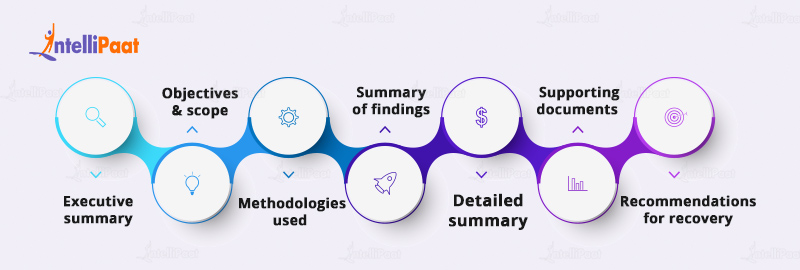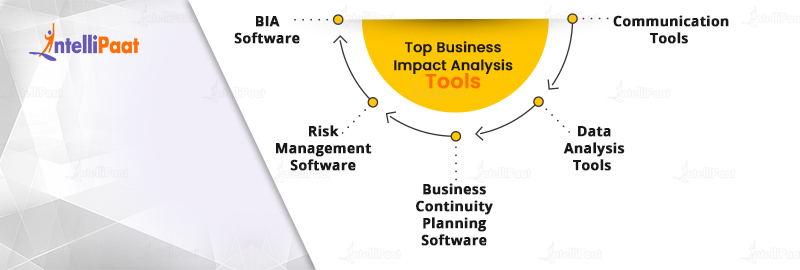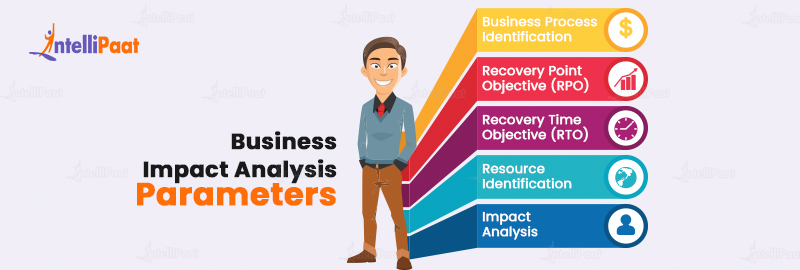What is Business Impact Analysis?
Businesses can never be too cautious about what will come for them in the coming quarters, months, or years. In a world where everything is volatile, it becomes imperative for Businesses to foresee what channels, functions, and processes within the organization may falter or grow.
This principle is the essence of Business Impact Analysis or BIA, governed by one real testament. This testament says that at all points in time, a business should be able to forecast or predict the potency of all its functions and have its arsenal of recovery strategies ready to deal with such events.
Table of Contents:
- Introduction to Business Impact Analysis
- Business Impact Analysis Process
- Top Business Impact Analysis Tools
- Business Impact Analysis Parameters
- Conclusion
Start your learning with us, watch our YouTube video on
Introduction to Business Impact Analysis

Business Impact Analysis is a vital component of business continuity plans. BIA is a structured approach used to determine, evaluate, and prioritize the potential impacts of a disturbance on business operations. One of the most important roles of BIA is to develop a recovery plan from these interruptions. BIA covers all the major real-life scenarios of potential threats to business operations, ranging from cyber attacks to natural disasters.
- BIA considers the critical functions, processes, and dependencies of an organization, to determine the potential impact of an interruption.
- It helps businesses to assess the potential consequences of a disaster, and develop various types of strategies to mitigate the impact of such events.
- BIA governs the risk management process, it provides businesses with valuable insights related to the potential impact on the business.
- This analysis helps companies to prioritize their resources and efforts to minimize the impact of any disruption on business operations.
- Irrespective of the type of potential disturbance, BIA makes sure that business operations keep running smoothly.
Kickstart your Business Analytics journey with us. Enroll in our Business Analyst Training Program.
Business Impact Analysis Process

Business impact analysis is executed by the project team of organizations. As mentioned earlier, business impact analysis follows a well-structured process to carry out the impact analysis. This analysis holds the major crux for businesses to run smoothly. It is important to have a basic understanding of the impact analysis process.
There is no set template for conducting BIA, but we will introduce the general template for BIA execution. Below mentioned are the various stages and steps that are carried out during the business impact analysis.
- Getting Approval – In this step, we seek necessary approvals from the concerned authorities to carry out a business impact analysis. We also define the objective, parameters, and scope of the assessment. This step can be outsourced to third-party organizations if the team is not available within the organization.
- Information Gathering – This is an important step of the BIA assessment. Here, we gather the information that is required during the various phases of the assessment. We seek information like details of the processes, records of resource allocation, tools utilized, and the timings on which the process is carried out.
- Information Rectification – This is co-dependent on the previous step of the assessment. In this step, we rectify the gathered information. We also make necessary changes to the feedback received from various information sources. This step can also be automated by the computer systems if needed by the firm.
- Documentation and Presentation – This is the final step of the assessment. In this step, we document the gathered records from various sources and form a document with a peculiar format.

Curious about being a business analyst? Check out the complete path of How to Become a Business Analyst in 2023?
Top Business Impact Analysis Tools

Business impact analysis is a vital process that is needed to be performed to minimize the impact of unintended interruption on the business continuity plan. The analysis is executed using various tools. Below mentioned are the various types of tools that you are required to master to execute BIA effectively.
BIA Software –
BIA software is an essential tool for conducting a comprehensive business impact analysis. It allows businesses to automate the BIA processes, making them faster, more accurate, and more efficient. BIA software can help identify critical business processes, assess the impact of disruptions, and prioritize recovery efforts.
Risk Management Software –
Risk management software is an important tool for conducting a BIA. It helps businesses identify and assess potential risks and provides tools for managing those risks. By identifying risks early, businesses can take steps to mitigate or avoid them altogether.
Business Continuity Planning Software –
Business Continuity Planning (BCP) software is designed to help businesses develop and implement a plan for maintaining essential business operations during a disruption. It can help identify critical resources and processes, assess the potential impact of disruptions, and develop strategies for recovery.
Data Analysis Tools –
Data analysis tools can be used to assess the impact of disruptions on critical business processes and resources. It has a similar working as that of BIA software.
Communication Tools –
Effective communication is essential during a disruption. Communication tools such as mass notification systems and crisis communication platforms can help businesses keep employees and customers informed during a disruption. These tools can also help businesses coordinate recovery efforts and ensure a timely return to normal operations.
Business Impact Analysis Parameters

Execution of business impact analysis provides an upper hand to organizations. Below we have mentioned a few major impact analysis parameters that you have to consider will executing business impact analysis.
Business Process Identification –
The first step in the BIA process is identifying the business processes that are critical to the organization’s success. These processes may include manufacturing, sales, customer service, or any other processes that are essential to the organization’s operations. It is important to document each process and identify any dependencies between them.
Recovery Time Objective (RTO) –
The Recovery Time Objective (RTO) is the time it takes to restore a business process to its normal operations after a disruption. It is essential to establish RTOs for each critical business process to ensure that the organization can quickly recover from a disruption. A shorter RTO means a faster recovery time, which is critical for minimizing the impact of a disruption.
Recovery Point Objective (RPO) –
The Recovery Point Objective (RPO) is the maximum amount of data that can be lost in a disruption without significant impact on the organization. This parameter is closely related to the backup and recovery strategy of the organization. It is important to establish RPOs for each critical business process to ensure that the organization can recover data and information after a disruption.
Resource Identification –
Resource identification involves identifying the resources needed to restore critical business processes after a disruption. These resources may include personnel, equipment, facilities, or any other resources needed to resume normal operations.
Impact Analysis –
The impact analysis involves assessing the potential impact of a disruption on the organization’s critical business processes. This assessment should include both quantitative and qualitative factors, such as financial losses, reputation damage, and customer impact. This information will help organizations prioritize their recovery efforts and ensure that critical business processes are restored first.
Enhance your interview preparedness with us. Visit Top Business Analyst Interview Questions and Answers.
Conclusion
In today’s rapidly changing business landscape, conducting a Business Impact Analysis has become even more critical. By conducting a BIA, companies can not only minimize the risks associated with potential disruptions but also enhance their resilience and ability to respond to crises. A well-executed BIA can help organizations identify potential vulnerabilities and develop effective contingency plans to minimize the impact of such disruptions.
Catch up with your fellow learner and resolve your doubts. Join Intellipaat’s community.
The post What is Business Impact Analysis? appeared first on Intellipaat Blog.
Blog: Intellipaat - Blog
Leave a Comment
You must be logged in to post a comment.







